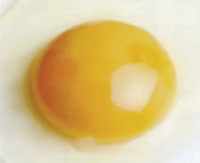
Mottled yolks and discoloured yolks

Description
The colour of the yolk may be uneven or patchy, as shown, or vary from the desired colour range (deep-yellow to orange-yellow).
Incidence
Some degree of mottling occurs in more than 50% of all eggs. The severity of mottling increases as eggs become stale. Discoloured yolks are rare.
| Cause | Control |
|---|---|
| Mottled yolks have been attributed to: | |
| Poor handling and storage | Minimise storage time on the farm by:
• increasing the number of pick-ups per week for grading or delivery to retail outlets. • collecting and packing eggs laid on pick-up days so that they are consigned on that day. • grading eggs while they are fresh when packing on the farm. Do not allow the temperature in the layer shed to become too high. Keep the coolroom temperature below 20 °C, e.g. at 12 to 15 °C (guidelines/requirements may vary in different countries) and the humidity at 70 to 80%. Examine egg handling procedures and equipment and modify to minimise rough handling. Oil eggs soon after collection. Use only an oil approved for this purpose by the relevant authorities. |
| Thin shells | Make sure that feed contains the correct amounts and proportions of nutrients, particularly calcium. |
| Gossypol in cottonseed meal | Limit cottonseed meal with high gossypol content to 5% of the layer diet (recent work indicates that up to 10% of some solvent-extracted cottonseed meal products can be safely used as they have low levels of gossypol due to newer varieties and improved processing). If the diet contains high gossypol cottonseed meal, add iron at the rate of 0.05% by weight of the diet. This can be achieved by adding ferrous sulphate powder at the rate of 0.25% by weight of the diet. |
| Treatment for worms | Do not use combinations of the worming drugs piperazine, phenothiazine and dibutyltin dilaurate immediately before or during lay. However, the use of any one of these drugs at the recommended and approved dose rate is not detrimental. |
| Certain antioxidants | Do not feed gallic acid or tannic acid to laying hens. |
| Raw soybean meal | Use only heat-treated soybean products in layer diets. |
| Discoloration of yolks has been attributed to: | |
| Gossypol in cottonseed meal | Prevent bluish-green yolks by limiting cottonseed meal with high gossypol content to 5% of the layer diet. New varieties and improved processing of CSM have been developed that have low levels of gossypol. If the diet contains cottonseed meal with high gossypol levels, add iron at the rate of 0.05% by weight of the diet. This can be achieved by adding ferrous sulphate powder at die rate of 0.25% by weight of the diet. |
| The weed shepherd’s purse | Prevent green yolks by excluding this plant from the diet. |
| Cyclopropene fatty acids in cottonseed and certain weeds, e.g. marshmallow | These substances may cause the yolk to become a salmon colour after storage. Exclude weeds from the layer diet. |
| DPPD (diphenyl-para-phenylenediamine) | The antioxidant DPPD (diphenyl-paraphenylenediamine) (where approved for use) can cause excessive amounts of pigments from the feed to be deposited into the yolk. |
| Worms or disease | Disease or infestation with capillaria worms (cropworms) can produce ‘blond’ or ‘platinum’ yolks. Follow effective vaccination programmes against disease, observe hygiene measures and control worms. |
| Balance of yellow to red pigments | A low yellow:red carotenoid ratio in the feed, for example 1.25:1, will produce apricot-coloured yolks. Maintain a yellow:red ratio of approximately 3:1, particularly when diets are low in natural pigments. |
COPYRIGHT NOTICE: OPTIMUM EGG QUALITY - A PRACTICAL APPROACH
© The State of Queensland, Australia (through its Department of Primary Industries and Fisheries) and DSM Nutritional Products Ltd., 2007. No part of this publication may be reproduced, copied or transmitted save with prior written permission of Director, Intellectual Property Commercialisation Unit, Department of Primary Industries and Fisheries, GPO Box 46 Brisbane, Queensland, Australia 4001, and DSM Nutritional Products Ltd.
© The State of Queensland, Australia (through its Department of Primary Industries and Fisheries) and DSM Nutritional Products Ltd., 2007. No part of this publication may be reproduced, copied or transmitted save with prior written permission of Director, Intellectual Property Commercialisation Unit, Department of Primary Industries and Fisheries, GPO Box 46 Brisbane, Queensland, Australia 4001, and DSM Nutritional Products Ltd.






